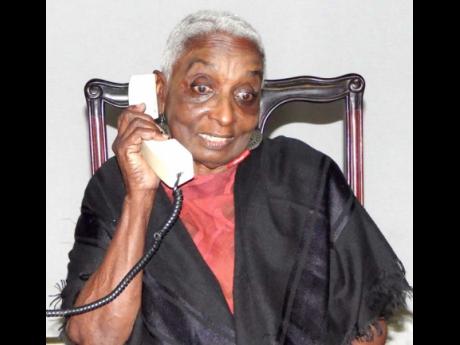(Jamaica Gleaner) “I couldn’t find my glasses,” Jean Small said.
She was explaining to The Sunday Gleaner, an extra-long, between-scenes wait that the audience had during her one-woman show, The Awful Truth, at the Philip Sherlock Centre for the Creative Arts (PSCCA) recently.
Happily, the audience was not upset. For one thing, the show was very short, with Small herself spending less than an hour on stage; for another, the three pieces making up the show were all powerfully acted and in that sense satisfying.
Still, the wait was an indication of one problem Small herself had been having: she needed more help. As she said: “In order to cut down on cost, I had to do a lot of the creative aspects of the play. I wrote the scripts, I directed myself in performance, I used my own clothes. I borrowed the old, miserable-looking wicker settee and shelving from the School of Drama. Everything else came from my home. I chose the music. I chose the visuals and had the CD prepared. I got help from a technician in Portmore to prepare the sound track. These were all prepared and handed to Nadia (Roxburgh, the PSCCA’s technical director). I had to loan the PSCCA my laptop and projector for my show.”
This is not to say Small did not get a lot of help. On the back page of the programme, she gives thanks for the help of some two dozen people and institutions, and there were six people beside her on stage taking the curtain call at the end of the show. Her statement just shows how much is involved in putting on a theatrical production, even a one-person show.
Summing up the experience, she told this writer, “I learnt a lot.”
She said that her on one-woman shows (another is her internationally acclaimed A Black Woman’s Tale) are very influenced by storytelling skills which she has practised over the years in Jamaica and abroad. Philosophically, she added, “I believe that storytelling is the legacy of our African ancestors and underlies the theatrical art form.
The overall subject of the pieces in The Awful Truth: Miriam’s Misery, Too Late To Cry and Balance, is love. Two are about women expressing maternal love (in quite different ways), and one about a woman reaching out unsuccessfully, for love.
The pieces are based on Small’s “reflections and observations of real-life situations”. The inspiration for Miriam’s Misery came from a television programme about a successful young man who never knew his mother as she had tossed him into a garbage bin shortly after birth.
“The question I asked myself,” said Small, “was, ‘Why does a woman do that?’ ” The question led to her interviewing many women and using the information she got to create the harrowing piece.
“Miriam is a survivor,” said Small. “I was dealing with the problem in Jamaica of women depending on men, getting pregnant, having too many babies and the strength to discard the baby instead of having the child suffer in poverty. It is in the psyche of our women to make that decision from the days of slavery when they did not want their babies to have the terrible experience of slavery. They threw the babies overboard on the Middle Passage.”
Miriam’s Misery, shows a pregnant woman in a threadbare dress sitting on a dilapidated couch in an impoverished room talking about her miserable lot in life. Abusive relationships have left her with four children by four fathers and fears about what the children will become. She doesn’t want the fifth child, and when it is born – during a brief dimming of the stage lights – she throws it in the garbage bin on the street. But the disposal is done in the context of an African ritual, signifying the handing over of the baby to Papa Legba – the African god of the crossroads, according to Small.
In fact, a masked garbage man collects it. In an imagined court trial scene, the mother denies killing the baby boy and begs someone in the courtroom who, she thinks, has the baby to let her hold him.
The short play ends with the playing of the Seretse Small guitar rendition of Bob Marley’s No Woman No Cry. Another theatrical dimension was given to the piece by images of poverty and neglect projected onto the backdrop.
Too Late To Cry, the second piece, shows a better-dressed woman – and we learn she is a homeowner – talking to her jailed 23-year-old son, who is behind bars upstage. His back is to her and the audience, for most of the time, too ashamed to face his mother who pours out her sad tale of working hard and sacrificing for him, only to have him get arrested on gun charges.
Ironically, what Miriam, in the first piece, feared might happen to her children because they were growing up poor, happens to the mother in the second piece, though she is comparatively well-off. The women in these two pieces are definitely not winners, but they are loving in their different ways.
Balance

The character in the third piece, Balance, is a lonely 79-year-old woman who gets a series of phone calls from a smooth-talking man. She tells a friend (by phone) that she hopes the man wants her companionship, but when the man phones again, she, and we the audience, discover he has much more sinister intentions.
The show and Small were introduced by Scarlette Beharie, who said she abandoned her initial dreams of becoming an actress in favour of behind-the-scenes work in theatre. The lovely singing of two songs, Fly Away Home and I Dreamed a Dream, by Jodi HoLung during a break between pieces, helped immensely to lighten the mood of the show, which one patron called bleak. Other live music and sound effects were provided offstage by the one-man band, M’Bala.
Small hopes to remount the show if she can get a suitable venue.
